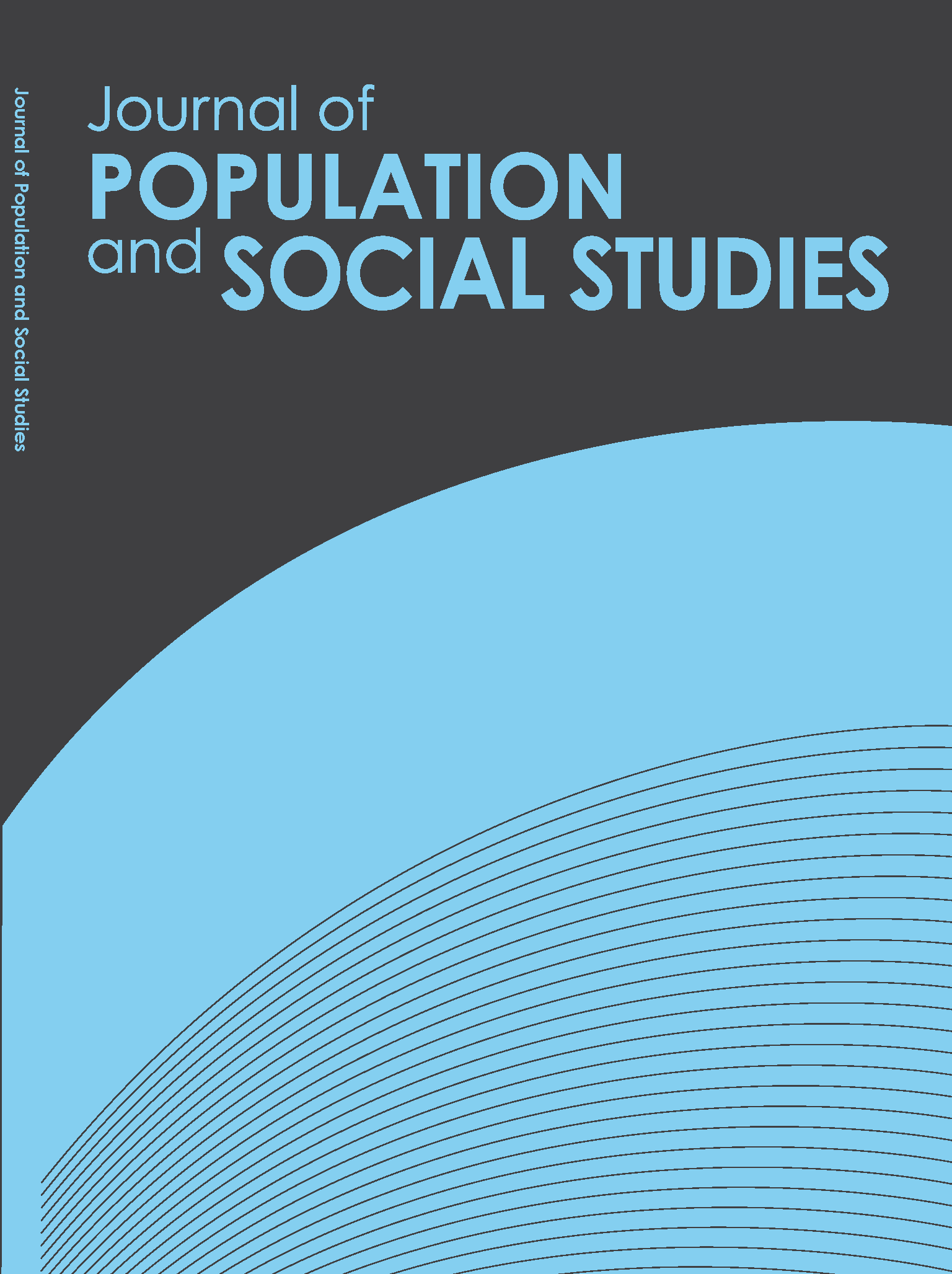Factors Affecting Readmission to a Drug Rehabilitation Center in Brunei Darussalam
Main Article Content
Abstract
The objective of this study is to examine the sociodemographic factors contributing to the readmission to a drug rehabilitation center among drug addicts in Brunei Darussalam. This retrospective study used de-identified data obtained from the Al-Islah Rehabilitation Center for the period 1 January 2010 to 31 December 2017. Univariate and multiple logistic regression analyses with a stepwise variable selection method were used to estimate and determine significant factors associated with readmission to the center. A total of 92 out of 705 subjects (13%) were readmitted to the rehabilitation center within the study period, with ages ranging from 20 to 59 years (M = 36.1, SD = 8.6 years). Multiple logistic regression found that subjects who were in the age group of 40 to 49 (OR = 2.24, 95% CI [1.16, 4.37]) resided in the Belait district (OR = 1.94, 95% CI [1.00, 3.63]), divorced or widowed (OR = 2.14, 95% CI [1.19, 3.82]), had committed other criminal offenses (OR = 1.91, 95% CI [1.16, 3.11]), and voluntarily admitted (OR = 2.33, 95% CI [1.34, 4.01]), were found to be significantly more likely to get readmitted to the rehabilitation center. This study provides evidence of sociodemographic factors in relation to readmission to the rehabilitation center in Brunei Darussalam.
Article Details

This work is licensed under a Creative Commons Attribution-NonCommercial-NoDerivatives 4.0 International License.
References
• AIPA Advisory Council on Dangerous Drugs (AIPACODD). (2019). Report of the second meeting of the AIPA Advisory Council on Dangerous Drugs. https://aipasecretariat.org/post-1852/
• Arning, L. (2017). Predicting readmission to detoxification in clients with alcohol and drug dependence. [Unpublished master’s thesis]. The University of Twente. https://essay.utwente.nl/73366/
• Ball, J. C., Thompson, W. O., & Allen, D. M. (1970). Readmission rates at Lexington Hospital for 43,215 narcotic drug addicts. Public Health Reports, 85(7), 610–616. https://doi.org/10.2307/4593918
• Camí, J., & Farré, M. (2003). Drug addiction. New England Journal of Medicine, 349(10), 975–986. https://doi.org/10.1056/NEJMra023160
• Chi, F. W., Weisner, C., Grella, C. E., Hser, Y. I., Moore, C., & Mertens, J. (2014). Does age at first treatment episode make a difference in outcomes over 11 years? Journal of Substance Abuse Treatment, 46(4), 482–490. https://doi.org/10.1016/j.jsat.2013.12.003
• Department of Economic Planning and Statistics. (2019). Population. Ministry of Finance and Economy, Brunei Darussalam. http://www.deps.gov.bn/SitePages/Population.aspx
• Department of Statistics. (2017). Report of summary findings: Labour Force Survey 2017. Department of Economic Planning and Development, Ministry of Finance and Economy, Brunei Darussalam. https://deps.mofe.gov.bn/DEPD%20Documents%20Library/DOS/Labour%20force%20survey_KTK/2017/Sum_FindingsLFS2017.pdf
• Department of Statistics. (2018). Laporan Anggaran Penduduk Pertengahan Tahun 2018 [Report of the Mid-Year Population Estimates 2018]. Department of Economic Planning and Development, Ministry of Finance and Economy, Brunei Darussalam. http://www.deps.gov.bn/DEPD%20Documents%20Library/DOS/POP/2018/Rep_MidYr_2018.pdf
• Ferri, C. P., Gossop, M., Rabe-Hesketh, S., & Laranjeira, R. R. (2002). Differences in factors associated with first treatment entry and treatment re-entry among cocaine users. Addiction, 97(7), 825–832. https://doi.org/10.1046/j.1360-0443.2002.00130.x
• Gonzales, R., Anglin, M. D., Beattie, R., Ong, C. A., & Glik, D. C. (2012). Perceptions of chronicity and recovery among youth in treatment for substance use problems. Journal of Adolescent Health, 51(2), 144–149. https://doi.org/10.1016/j.jadohealth.2011.11.010
• Kanato, M., Choomwattana, C., Sarasiri, R., & Leyatikul, P. (Eds.) (2018, August). ASEAN Drug Monitoring Report 2017. ASEAN Narcotics Cooperation Center. https://asean.org/wp-content/uploads/2016/10/Doc-3-ADM-Report-2017-as-of-16-Aug18-FINAL.pdf
• Luchansky, B., & He, L. (1999, December). Substance abuse treatment in Washington State: Constructing treatment episodes and analyzing readmissions: An Interim Report. Washington State Department of Social and Health Services. https://www.dshs.wa.gov/sites/default/files/rda/reports/research-4-31.pdf
• Masli, U. (2010, February 12). A ‘therapeutic community’ at Al-Islah. The Brunei Times. https://btarchive.org/news/national/2010/02/12/therapeutic-community-al-islah
• Melnick, G., De Leon, G., Thomas, G., & Kressel, D. (2001). A client-treatment matching protocol for therapeutic communities: first report. Journal of Substance Abuse Treatment, 21(3), 119–128. https://doi.org/10.1016/s0740-5472(01)00191-x
• Moos, R. H., Pettit, B., & Gruber, V. (1995). Longer episodes of community residential care reduce substance abuse patients’ readmission rates. Journal of Studies on Alcohol and Drugs, 56(4), 433–443. https://doi.org/10.15288/jsa.1995.56.433
• Narcotics Control Bureau. (2015). Supervision Scheme. Prime Minister’s Office, Brunei Darussalam. http://www.narcotics.gov.bn/SitePages/Supervision%20Scheme.aspx
• Polenberg, S. (2015). Factors affecting success and failure among drug court participants in the United States: An examination of program completion and post-program outcomes. [Unpublished master’s thesis]. The University of Miami. https://scholarship.miami.edu/esploro/outputs/991031448076202976
• Robbins, C. A., Martin S. S., & Surratt, H. L. (2009). Substance abuse treatment, anticipated maternal roles, and reentry success of drug-involved women prisoners. Crime & Delinquency, 55(3), 388–411. https://doi.org/10.1177/0011128707306688
• Sharbawi, S., & Mabud, S. A. (2021). Malay, Muslim and Monarchy: An introduction to Brunei Darussalam and its national identity. In L. H. Phan, A. Kumpoh, K. Wood, R. Jawawi, & H. Said (Eds.), Globalisation, education, and reform in Brunei Darussalam (pp. 45–66). International and Development Education. Palgrave Macmillan, Cham. https://link.springer.com/chapter/10.1007/978-3-030-77119-5_3
• Sau, M., Mukherjee, A., Manna, N., & Sanyal, S. (2013). Sociodemographic and substance use correlates of repeated relapse among patients presenting for relapse treatment at an addiction treatment center in Kolkata, India. African Health Sciences, 13(3), 791–799. https://doi.org/10.4314/ahs.v13i3.39
• Steffensmeier, D., & Allan, E. (1996). Gender and crime: Toward a gendered theory of female offending. Annual Review of Sociology, 22, 459–487. https://doi.org/10.1146/annurev.soc.22.1.459
• Trujols, J., Guàrdia, J., Peró, M., Freixa, M., Siñol, N., Tejero, A., & de Los Cobos, J. P. (2007). Multi-episode survival analysis: An application modelling readmission rates of heroin dependents at an inpatient detoxification unit. Addictive Behaviors, 32(10), 2391–2397. https://doi.org/10.1016/j.addbeh.2007.02.008
• Walters, G. D. (2002). Lessons learned from project MATCH. Addictive Disorders & Their Treatment, 1(4), 135–139. https://doi.org/10.1097/00132576-200211000-00004
• Wolfe, E., Guydish, J., & Termondt, J. (2002). A drug court outcome evaluation comparing arrests in a two year follow-up period. Journal of Drug Issues, 32(4), 1155–1172. https://doi.org/10.1177/002204260203200410


